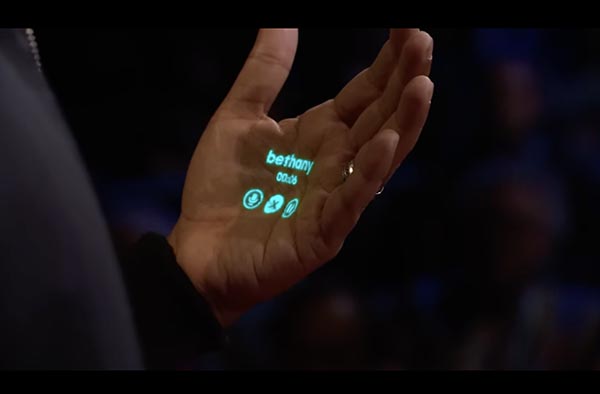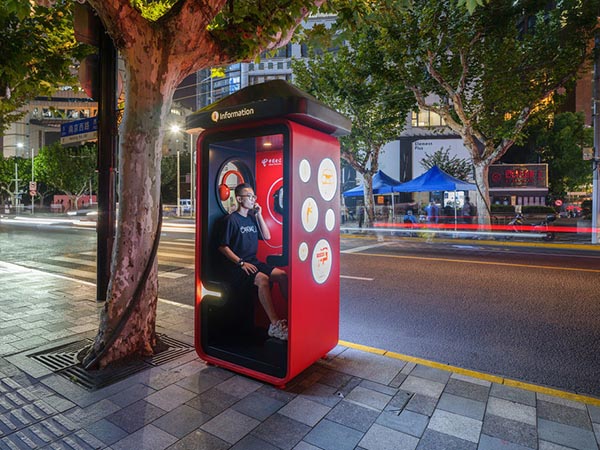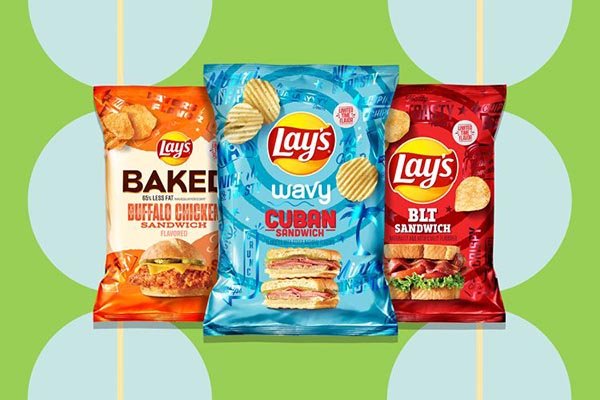Talk to the Hand
Via Boing Boing, former Apple designer and co-founder of Humane Imran Chaudhri demonstrates via TED Talk a new product the company is developing: an AI-powered device featuring a camera and “listening capabilities.” It’s small enough to fit on a shirt pocket and, crucially, lacks a screen, allowing the display to be projected on one’s hand—almost literally a Palm Pilot.
It’s a new kind of wearable device and platform that’s built entirely from the ground up for artificial intelligence. And is completely standalone. You don’t need a smartphone or any other device to pair with it. In fact, I’m wearing one right now. And it interacts with the world the way you interact with the world. Hearing what you hear, seeing what you see. While being privacy-first and safe and completely fading into the background of your life.

During the TED Talk, he answers a call from his wife on his hand, and demonstrates its language translation features.
You’ll note that’s me, and my voice, speaking fluent French, using an AI speech model that's part of my own AI. This is not a deepfake. In fact, it’s deeply profound. This is my AI giving me the ability to speak any language and you having a chance to hear me speak that language in my own emotion and my own voice.
There’s far more to it than that. Is it the future of computing? If so, it’s pretty handy. Check out the whole demo:
Deadaverse
Over at Business Insider, a lengthy obituary for the Metaverse, which is describes as a “once-buzzy technology that promised to allow users to hang out awkwardly in a disorientating video-game-like world”. Remember when the Metaverse was going to be the future of computing, or the Internet, or social media, or whatever it was going to be the future of?
After a much-heralded debut, the Metaverse became the obsession of the tech world and a quick hack to win over Wall Street investors. The hype could not save the Metaverse, however, and a lack of coherent vision for the product ultimately led to its decline. Once the tech industry turned to a new, more promising trend — generative AI — the fate of the Metaverse was sealed.
The Metaverse is now headed to the tech industry's graveyard of failed ideas. But the short life and ignominious death of the Metaverse offers a glaring indictment of the tech industry that birthed it.
Part of the problem is that it was never entirely clear was the Metaverse was or why anyone would use it.
The inability to define the Metaverse in any meaningful way didn’t get in the way of its ascension to the top of the business world. In the months following the Meta announcement, it seemed that every company had a Metaverse product on offer, despite it not being obvious what it was or why they should.
Well, even Mark Zuckerberg has abandoned it.
But the Metaverse was officially pulled off life support when it became clear that Zuckerberg and the company that launched the craze had moved on to greener financial pastures. Zuckerberg declared in a March update that Meta's “single largest investment is advancing AI and building it into every one of our products.”
As the song goes, “Don’t believe the hype.”
Paintbox By Numbers
We’re waiting for a Frank video about this, but over at Print magazine, a celebration of the Quantel Paintbox, the world’s first digital imaging tool.
The Paintbox was the first user-friendly digital studio—but at $250,000 it was out of reach for most artists, so Quantel donated them to art colleges, invited artists to be involved in its development and ran a paid apprentice scheme for emerging creators who wanted to learn highly sought after digital skills. “A Paintbox software engineer told me his proudest achievement was that his work enabled so many artists’ successful careers and, being paid $500 an hour in 1986, that included mine,” he notes.
The system is the focus of a new exhibit, “How Quantel’s Paintbox Changed the World,” which debuted at the Phoenix Cinema & Arts Center’s Computer Arts Society in Leicester, UK. It will then travel to the British Computer Society in London in December. The event celebrates the 50th anniversary of the founding of Quantel, which introduced the Paintbox in 1981.
A curated set of 20 printed Quantel Paintbox images will be on view during the exhibition. This will be the first time this selection by international artists, including Keith Haring and David Hockney, has been shown together. The show also includes pioneering digital work by Richard Bernstein, April Greiman, Richard Hamilton, Ellen and Lynda Kahn, Sidney Nolan, Kiki Picasso, Larry Rivers and more.

© April Greiman, MoMA & AIGA posters, 1988.
A documentary on Quantel and the Paintbox is reportedly in the works, as well.
What Are the Odds
WhatTheyThink contributor Mark V (heir to the throne of Mark IV) points us to the latest development in the ongoing trend to convert old newspaper printing plants into other kinds of establishments—in this case, the Chicago Tribune’s press room is being converted to a casino. From the Sun-Times:
Tribune Publishing will move its newspaper printing plant next year, making way for a Chicago casino, under an agreement it has reached with Bally’s, according to the Chicago Tribune.
The casino operator reportedly will buy out Tribune’s lease on the property at 777 W. Chicago Ave. Bally’s bought the 30 acres for $200 million last year after winning City Hall’s blessing to build the first casino inside city limits.
But Tribune still was tied to the site on a long-term lease, leaving a financial wrinkle to be ironed out before Bally’s could proceed with its promised $1.7 billion gambling and entertainment center.
You may recall a video Frank did some time ago about newspaper headquarters being converted into condos and luxury apartments. (And some of us are fond of Syracuse, N.Y.’s Press Room Pub, in which the old Herald Journal printing plant was converted into a very nice sports bar.)
Copying Graphene
Was it a good week for graphene news? It’s always a good week for graphene news! Graphene nanotubes combine conductivity and durability in polyimide film. From (who else?) Graphene-Info a press release received from OCSiAl:
The polyimide films used for the rollers of industrial/office copiers and printers (fuser rollers for example) suffer from rapid wearing under high temperature and dry sliding friction conditions. Another challenge that occurs in this type of equipment is the formation of electrostatic charges caused by friction at high printing speed. All of these factors can lead to film deterioration, streaking, smudging, black lines, paper jams, or wrinkles. Product damage ultimately increases production costs, therefore manufacturers have to search for new advanced solutions, such as carbon black powder, which has traditionally been used as a conductive agent to eliminate the risk of ESD. But it shows drawbacks in most demanding applications.
As always, graphene to the rescue.
Manufacturers of core components for laser composite machines and printers have developed a new high performance conductive polyimide film with graphene nanotubes with a thickness of <100µm. These advanced films offer an excellent balance of electrical, mechanical, physical, and chemical properties over a wide range of temperatures, extending the potential use of PI films to a broader range of applications.

Graphene nanotubes
More information can be found here.
Phoning it In
About a year ago, we linked to a story about the last remaining phone booth being removed from New York City (they are planning on installing wi-fi kiosks around the city). Now, via Core 77, Shanghai is installing all-new, high-tech phone booths.
International architecture studio 100architects, in partnership with China Telecom, was asked to reimagine these urban relics as relevant modern-day conveniences. The result is their Shanghai Smart Booth, “a unique type of urban artifact powered by solar panels on its roof, with a sophisticated design that demonstrates the infinite potential of creative thinking about the urbanscape and public realm.”

The new phone booths will enable free phone calls, wi-fi, device charging, maps, ride-hailing, and elderly assistance. And, as quaint as the notion of a phone booth may be, there are times when one is walking around the streets of a city and needs a quietish place to make a call or even send a text without stopping abruptly in the middle of a sidewalk. Unfortunately, they often doubled as rest rooms.
Hosed
Adapters. Don’t get us started on adapters. Since the advent of computing, we have needed a stunning variety of adapters to connect computers and devices. Even in the so-called Golden Age of Wireless, we still need adapters of various kinds. One unique adapter, via Boing Boing, was 3D-printed by a TikToker—it’s a garden hose-to-HDMI adapter.
After all, who among us doesn’t occasionally need to download water?

What Did I Come Online For?
Well, this headline was some good news for those of us in the Around the Web Cultural Accretion Bunker: “Regular internet use may be linked to lower dementia risk in older adults, study says.” From CNN:
A study published Wednesday in the Journal of the American Geriatrics Society suggested that older people who regularly used the internet were less likely to develop dementia.
The researchers saw this association after about eight years tracking 18,154 adults between the ages of 50 and 65 who did not have dementia when the study period began.
The nut ’graph, as they say:
People who used the internet at the start of the study had about half the risk of dementia as people who were not regular users.
The amount of time spent online may be a factor as well.
The researchers also looked at how often these adults were online, from not at all to more than eight hours a day. Those who used the internet for about two hours or less a day had the lowest risk of dementia compared with those that didn’t use the internet, who had a “notably higher estimated risk.”
The researchers noted that people who were online six to eight hours a day had a higher risk of dementia, but that finding wasn’t statistically significant, they said, and more research is needed.
The researchers believe that the reason is related to online activity keeping the brain engaged (insert own joke here) in much the way that doing crossword puzzles or other such pastimes keep the mind alert. Although, be honest, scientists still don’t fully understand what causes dementia.
“Online engagement may help to develop and maintain cognitive reserve, which can in turn compensate for brain aging and reduce the risk of dementia,” said Chang, an associate professor of global public health at New York University’s School of Global Public Health.
Spending time on social media is apparently good for brain health—mental health…well, that’s a little iffier.
Endless Pastabilities
This came over our transom late last week, after last Friday’s Around the Web had been copied into floppy disk and sent by bicycle messenger to the WhatTheyThink Death Star for processing, disinfecting, and publishing.
It sounds like a mob hit that went awry. From the Philadelphia Inquirer:
Mountains of spaghetti and heaps of elbow noodles lined a creek in the woods in New Jersey’s Old Bridge Township. No one seems to know where it came from, but the photos have social media boiling.
Hey, PI, bad puns are our department.
An Old Bridge spokesperson told the Inquirer Thursday that the Department of Public Works “visited the site and did in fact find what appeared to be 15 wheel barrel loads of illegally dumped pasta along a creek in a residential neighborhood.”
(By the way, it wasn’t cooked pasta, but rather dry pasta that became al dente thanks to heavy rains. Still, though…)
Believe it or not, there is an environmental concern.
“You might say, ‘Who cares about pasta?’ But pasta has a PH level that will impact the water stream,” Jochnowitz said. “That water stream is important to clean up because it feeds into the town’s water supply. ... It was one of the fastest cleanups I’ve ever seen here”
Who dumped it remained a mystery…but not for long.
Neighbors said that the oodles of noodles
Et tu, Channel 4?
came from a nearby home that is up for sale. A military veteran moving out of his mother's home after her death seemingly found a stockpile of old food that she had kept in the house.
“I mean, I really feel like he was just trying to clear out his parents’ house and they were probably stocked up from COVID,” said neighbor Keith Rost, saying it's a generational thing. “My grandparents always had a cupboard full of cans and pasta, just to be safe.”
Could have been worse. It could have been raw fish or 500 pounds of limburger cheese.
In other pasta news, Italy has a more serious problem: pasta inflation. From Reuters:
Italy’s Industry Minister Adolfo Urso called on Thursday for a crisis meeting over prices for pasta, the country’s favourite staple, after they jumped by more than double the national inflation rate.
Urso’s ministry said the cost of spaghetti and other pasta products rose year-on-year by 17.5% in March despite a drop in wheat prices. In that month, Italian EU-harmonised consumer prices (HICP) rose overall by 8.1%.
This is an odd line:
Competent authorities and trade and consumer associations will take part in it, it added.
One would hope. If they find any, maybe send them over here when they’re done.
Good Grief
There was an old sitcom joke we remember involving a lawyer defending a murder suspect:
Defense: My client came from a broken home.
Prosecution: Of course he came from a broken home. He killed his parents!
Yeah, it wasn’t a show that lasted very long. At any rate, this story brought that bit of dark humor back. From AP:
After her husband died last year, she wrote a children’s book on grief. Now she’s charged with his murder.
Well, they do say “write what you know.”
Kouri Richins was arrested on Monday in Utah and is accused in charging documents of poisoning her husband with a lethal dose of fentanyl at their home in Kamas, a small mountain town near Park City.
…For a segment entitled “Good Things Utah,” Richins called her husband’s death unexpected and described how it sent her and her three boys reeling. For children, she said, grieving was about “making sure that their spirit is always alive in your home.”
“It’s — you know — explaining to my kid just because he’s not present here with us physically, doesn’t mean his presence isn’t here with us,” she told the anchors, who commended her for being an amazing mother.
Amazing mother, yes. But wife? Well, the jury is (almost literally) out on that.
Lay's It on the Line
Although it a myth that the Earl of Sandwich invented the foodstuff that bears his name (he did popularize the sandwich, hence the eponym), but we’re not sure what he would make of Lay’s new concoction. Says Food & Wine:
Lay’s is now offering the BLT Sandwich chip, which, according to the brand, “combines the flavors of smoky bacon and tomato in a savory, crisp spin on one of America’s most beloved sandwiches.” It's also selling the Lay’s Wavy Cuban Sandwich, which “combines the traditional flavors of pork and cheddar cheese in a fresh take on a classic sandwich.” And finally, fans can snag a bag of Baked Lay’s Buffalo Chicken Sandwich, which “delivers flavors of cheese and zesty buffalo sauce.”

So if you had these chips as well as an actual corresponding sandwich, would you then be having two sandwiches?
Speaking of combining different foods into one object or substance, some weeks ago we linked with horror to Hidden Valley’s new ranch-flavored ice cream. Via Boing Boing, here is a reaction video of some college students trying it.
The secret, apparently, is to treat it as a dip for potato chips, but probably not those sandwich chips.
Did anything catch your eye “around the Web” this week? Let us know at [email protected].
This Week in Printing, Publishing, and Media History
May 8
1880: French novelist Gustave Flaubert dies (b. 1821).
1886: Pharmacist John Pemberton first sells a carbonated beverage named “Coca-Cola” as a patent medicine.
1912: Paramount Pictures is founded.
1920: American graphic designer and director Saul Bass born.
1926: English environmentalist and television host David Attenborough born.
A very happy 93rd birthday to Sir #DavidAttenborough! ??
— BBC (@BBC) May 8, 2019
As good a day as any to remember when he was upstaged by a bird... ????pic.twitter.com/VOuK5LqjGO
1926: American comedian and actor Don Rickles born.
1937: American novelist Thomas Pynchon born.
1980: The World Health Organization confirms the eradication of smallpox. (Well, for now, anyway...)
1984: American publisher, co-founder of Reader’s Digest Lila Bell Wallace dies (b. 1890).
1985: American author and critic Theodore Sturgeon dies (b. 1918).
1988: American science fiction writer and screenwriter Robert A. Heinlein dies (b. 1907).
May 9
1911: The works of Gabriele D’Annunzio are placed in the Index of Forbidden Books by the Vatican.
1958: Alfred Hitchcock’s film Vertigo has world premiere in San Francisco.
May 10
1824: The National Gallery in London opens to the public.
1869: The First Transcontinental Railroad, linking the eastern and western United States, is completed at Promontory Summit, Utah with the golden spike.
1902: American director and producer David O. Selznick born.
1954: Bill Haley & His Comets release “Rock Around the Clock,” the first rock and roll record to reach number one on the Billboard charts.
1962: Marvel Comics publishes the first issue of The Incredible Hulk.
1975: Sony introduces the Betamax videocassette recorder in Japan.
May 11
868: A copy of the Diamond Sutra is printed in China, making it the oldest known dated printed book.
1811: Thai-American conjoined twins Chang and Eng Bunker born.
1854: German-American engineer, invented the Linotype machine Ottmar Mergenthaler born.
1904: Spanish painter and illustrator Salvador Dalí born. (Fish.)
1942: William Faulkner’s collections of short stories, Go Down, Moses, is published.
2001: English novelist and screenwriter Douglas Adams dies (b. 1952). So long, and thanks for all the fish.
May 12
1593: London playwright Thomas Kyd is arrested and tortured by the Privy Council for libel.
1812: English poet and illustrator Edward Lear born.
1828: English poet and painter Dante Gabriel Rossetti born.
1846: The Donner Party of pioneers departs Independence, Mo., for California, on what will become a year-long journey of hardship and cannibalism.
1937: American comedian, actor, and author George Carlin born.
1941: Konrad Zuse presents the Z3, the world’s first working programmable, fully automatic computer, in Berlin.
May 13
1842: English composer Arthur Sullivan born.
1907: English novelist and playwright Daphne du Maurier born.
1922: German graphic designer and typographer Otl Aicher born.
1937: American author and poet Roger Zelazny born.
1944: American author, screenwriter, and actor Armistead Maupin born.
1954: The original Broadway production of The Pajama Game opens and runs for another 1,063 performances. It will later receive three Tony Awards for Best Musical, Best Performance by a Featured Actress in a Musical, and Best Choreography.
May 14
1925: Virginia Woolf’s novel Mrs Dalloway is published.
1944: George Lucas born. (May the 14th be with you....)
1952: Singer-songwriter, producer, and actor David Byrne born.
1993: American journalist and publisher William Randolph Hearst, Jr. dies (b. 1908).













